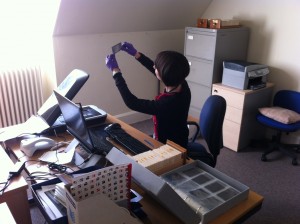On Tuesday the Sense of Place team had another visit to the Berkshire village of Bucklebury to meet the local history group. This time we were joined by Rebekkah, MERL’s ‘Historypinner in Residence’, who has been helping us upload our content to Historypin and develop a Historypin App for Bucklebury which draws on the content from our Historypin channel and from the Bucklebury History Group’s channel.
We met up with the Bucklebury History Group in a cosy pub in Upper Bucklebury and set ourselves up for an afternoon of ‘crowdsourcing’. Crowdsourcing is a form of distributed problem solving, which basically means putting a problem into the public domain for anyone to solve. In our case, we were using crowdsourcing to find out more about our Bucklebury photographs from the History Group.
We selected about 20 Bucklebury images – some taken by Philip Osborne Collier, a Reading photographer who was active 1905–1960s, and some taken by a former resident of Bucklebury in the 1950s. We chose these images for several reasons, e.g. because we wanted to know where they were taken, because we wanted to know who was in them, because we thought they were nice photographs, because we thought they might spark off interesting discussions etc. We were particularly keen to get more detailed information on where the photos were taken so that we could pin them more accurately to Historypin, and thus paving the way for making use of some of Historypin’s other functions, such as taking repeat photos which allow you to fade between historic and contemporary photos of the same view.

One of the Collier photos we crowdsourced, showing the houses near Turner’s Green and George Lailey’s hut in the distance.
The session was a great success! We had been planning to work in two smaller groups to try a couple of different ways of looking at the photos and recording the information, e.g. looking at the photos on laptops and on print outs, and recording the information on blank pieces of paper and on prepared forms. However, we ended up working together, gathered around a big screen onto which we projected the images. I acted as a scribe, scribbling down as much as I could about what was being said; Felicity sat with a map next to a very knowledgeable Bucklebury resident and recorded the location of each photo; and we had a dictaphone running to record any information we missed. The great thing about this was that everyone could pool their knowledge together and looking at digital images meant we could zoom in on particular areas of the photos (which were very high resolution) which we wouldn’t have been able to do had we been using printed photos.

This photo was given to the History Group by Rod Bisset, who grew up in Bucklebury. Felicity has managed to pin this to Historypin – the small tree by the bench is now a very large tree!
As a result of the crowdsourcing session, we now have much more accurate information on where the photos were taken and Felicity has been spending the day re-pinning the photos to the correct places. We’ve also generated some more contextual information about the photos, which Rebekkah is going to work on uploading as stories. We’ve also learnt how a crowdsourcing session actually works. Crowdsourcing is something Rebekkah does quite frequently for Historypin, but none of us had ever tried it before, so it was really good to give it a go and get some ideas on what worked well and what didn’t work so well, which can feed into other crowdsourcing sessions. I think that was probably the most positive outcome – that the Bucklebury History Group would like to do another session, so that’s hopefully something we’ll do in the spring. We’re also hoping to use what we’ve learnt to run a crowdsourcing session to look at some of the other photographic material we have at MERL – in particular, holding an intergenerational session with Young Farmers (and older farmers) to look at photographs from Farmers’ Weekly.
We had also been hoping to trial the Bucklebury App while we were there, but unfortunately I couldn’t get enough 3G signal for it to work reliably. I did manage a quick go using the pub’s wifi and was really pleased with what I saw. We’ve still got some more work to do on the App before we’re ready to make it public – including making use of the more accurately pinned photographs, and developing collections – but we’ll keep you posted on that.
Finally, I’d like to say a big thank you to Helen Relf of the Bucklebury History Group for making the arrangements for the session, and to Rebekkah for coming along and showing us how to crowdsource! And, to end on a positive note, one of the photos from the History Group’s channel is Historypin’s ‘Pin of the Day’ for today (17 January) so be sure to take a look.





